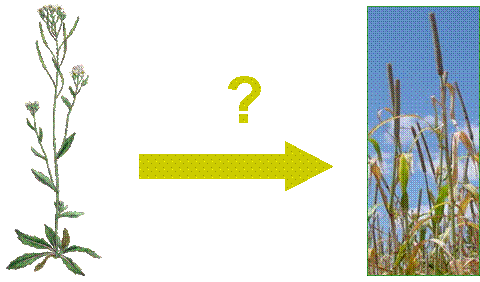Model plants: Arabidopsis

Arabidopsis thaliana (thale cress) was the first high-profile model plant. Arabidopsis was already used for research as long ago as the late 1800s, but this increased dramatically in 1980-90s, finally becoming the first plant genome to be fully sequenced, despite the species having absolutely no commercial usefulness.

|
The advantages of Arabidopsis as a model are: - Its genome size is small - Its generation time is only 6 weeks - It is easy to grow, very small, and produces a lot of seed - It is self-compatible - It is easily transformable - It is closely related to a major crop species (canola) |
Certainly Arabidopsis has some disadvantages as well. In particular, it does not produce fruit, and it is a dicot (while many of the world's food staples are monocots).
So there are definite limits to the amount of information which can be extrapolated to fruit-bearing plants and the cereals.






